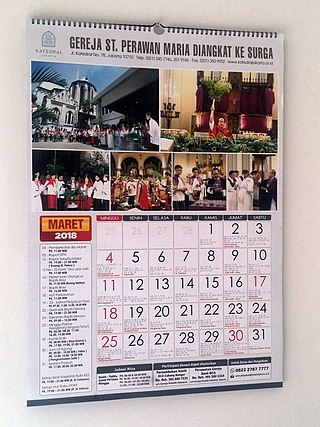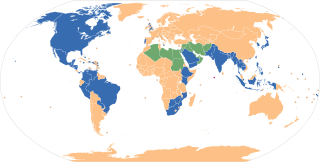
A calendar is a system of organizing days. This is done by giving names to periods of time, typically days, weeks, months and years. A date is the designation of a single and specific day within such a system. A calendar is also a physical record of such a system. A calendar can also mean a list of planned events, such as a court calendar, or a partly or fully chronological list of documents, such as a calendar of wills.

ISO 8601 is an international standard covering the worldwide exchange and communication of date and time-related data. It is maintained by the International Organization for Standardization (ISO) and was first published in 1988, with updates in 1991, 2000, 2004, and 2019, and an amendment in 2022. The standard provides a well-defined, unambiguous method of representing calendar dates and times in worldwide communications, especially to avoid misinterpreting numeric dates and times when such data is transferred between countries with different conventions for writing numeric dates and times.
A leap year is a calendar year that contains an additional day compared to a common year. The 366th day is added to keep the calendar year synchronized with the astronomical year or seasonal year. Because astronomical events and seasons do not repeat in a whole number of days, calendars that have a constant number of days in each year will unavoidably drift over time with respect to the event that the year is supposed to track, such as seasons. By inserting ("intercalating") an additional day or month into some years, the drift between a civilization's dating system and the physical properties of the Solar System can be corrected.
The International Fixed Calendar is a proposed calendar reform designed by Moses B. Cotsworth, first presented in 1902. The International Fixed Calendar divides the year into 13 months of 28 days each. A type of perennial calendar, every date is fixed to the same weekday every year. Though it was never officially adopted at the country level, the entrepreneur George Eastman instituted its use at the Eastman Kodak Company in 1928, where it was used until 1989. While it is sometimes described as the 13-month calendar or the equal-month calendar, various alternative calendar designs share these features.

A week is a unit of time equal to seven days. It is the standard time period used for short cycles of days in most parts of the world. The days are often used to indicate common work days and rest days, as well as days of worship. Weeks are often mapped against yearly calendars, but are typically not the basis for them, as weeks are not based on astronomy.
A common year starting on Sunday is any non-leap year that begins on Sunday, 1 January, and ends on Sunday, 31 December. Its dominical letter hence is A. The current year, 2023, is a common year starting on Sunday in the Gregorian calendar. The last such year was 2017 and the next one will be 2034 in the Gregorian calendar, or, likewise, 2018 and 2029 in the obsolete Julian calendar, see below for more.
A common year starting on Friday is any non-leap year that begins on Friday, 1 January, and ends on Friday, 31 December. Its dominical letter hence is C. The most recent year of such kind was 2021 and the next one will be 2027 in the Gregorian calendar, or, likewise, 2011, 2022 and 2033 in the obsolete Julian calendar, see below for more. This common year is one of the three possible common years in which a century year can begin on, and occurs in century years that yield a remainder of 100 when divided by 400. The most recent such year was 1700 and the next one will be 2100.
A common year starting on Monday is any non-leap year that begins on Monday, 1 January, and ends on Monday, 31 December. Its dominical letter hence is G. The most recent year of such kind was 2018 and the next one will be 2029 in the Gregorian calendar, or likewise, 2019 and 2030 in the Julian calendar, see below for more. This common year is one of the three possible common years in which a century year can begin on and occurs in century years that yield a remainder of 300 when divided by 400. The most recent such year was 1900 and the next one will be 2300.
Dominical letters or Sunday letters are a method used to determine the day of the week for particular dates. When using this method, each year is assigned a letter depending on which day of the week the year starts.
A leap year starting on Sunday is any year with 366 days that begins on Sunday, 1 January, and ends on Monday, 31 December. Its dominical letters hence are AG. The most recent year of such kind was 2012 and the next one will be 2040 in the Gregorian calendar or, likewise, 1996 and 2024 in the obsolete Julian calendar.
A leap year starting on Monday is any year with 366 days that begins on Monday, 1 January, and ends on Tuesday, 31 December. Its dominical letters hence are GF. The most recent year of such kind was 1996 and the next year will be 2024 in the Gregorian calendar or, likewise, 2008, and 2036 in the obsolete Julian calendar.
A common year starting on Thursday is any non-leap year that begins on Thursday, 1 January, and ends on Thursday, 31 December. Its dominical letter hence is D. The most recent year of such kind was 2015 and the next one will be 2026 in the Gregorian calendar or, likewise, 2021 and 2027 in the obsolete Julian calendar, see below for more.
A leap year starting on Saturday is any year with 366 days that begins on Saturday, 1 January, and ends on Sunday, 31 December. Its dominical letters hence are BA. The most recent year of such kind was 2000 and the next one will be 2028 in the Gregorian calendar or, likewise 2012 and 2040 in the obsolescent Julian calendar. In the Gregorian calendar, years divisible by 400 are always leap years starting on Saturday. The most recent such occurrence was 2000 and the next one will be 2400, see below for more.
A leap year starting on Friday is any year with 366 days that begins on Friday 1 January and ends on Saturday 31 December. Its dominical letters hence are CB. The most recent year of such kind was 2016 and the next one will be 2044 in the Gregorian calendar or, likewise, 2000 and 2028 in the obsolete Julian calendar.
A leap year starting on Thursday is any year with 366 days that begins on Thursday 1 January, and ends on Friday 31 December. Its dominical letters hence are DC. The most recent year of such kind was 2004 and the next one will be 2032 in the Gregorian calendar or, likewise, 2016 and 2044 in the obsolete Julian calendar.
A leap year starting on Wednesday is any year with 366 days that begins on Wednesday 1 January and ends on Thursday 31 December. Its dominical letters hence are ED. The most recent year of such kind was 2020 and the next one will be 2048 in the Gregorian calendar, or likewise, 2004 and 2032 in the obsolete Julian calendar, see below for more.
The determination of the day of the week for any date may be performed with a variety of algorithms. In addition, perpetual calendars require no calculation by the user, and are essentially lookup tables. A typical application is to calculate the day of the week on which someone was born or a specific event occurred.
The ISO week date system is effectively a leap week calendar system that is part of the ISO 8601 date and time standard issued by the International Organization for Standardization (ISO) since 1988 and, before that, it was defined in ISO (R) 2015 since 1971. It is used (mainly) in government and business for fiscal years, as well as in timekeeping. This was previously known as "Industrial date coding". The system specifies a week year atop the Gregorian calendar by defining a notation for ordinal weeks of the year.
The Hanke–Henry Permanent Calendar (HHPC) is a proposal for calendar reform. It is one of many examples of leap week calendars, calendars that maintain synchronization with the solar year by intercalating entire weeks rather than single days. It is a modification of a previous proposal, Common-Civil-Calendar-and-Time (CCC&T). With the Hanke–Henry Permanent Calendar, every calendar date always falls on the same day of the week. A major feature of the calendar system is the abolition of time zones.
A perennial calendar is a calendar that applies to any year, keeping the same dates, weekdays and other features.


